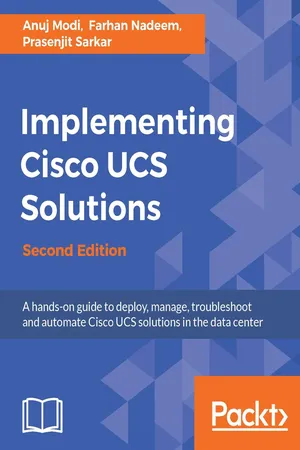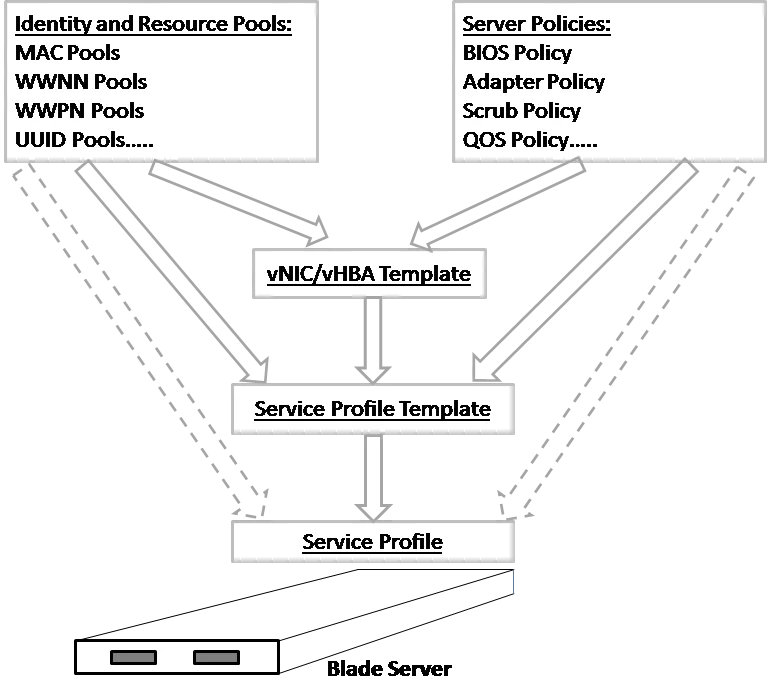
Implementing Cisco UCS Solutions - Second Edition
- 482 pages
- English
- ePUB (mobile friendly)
- Available on iOS & Android
Implementing Cisco UCS Solutions - Second Edition
About This Book
Discover how to simplify your data center architecture, reduces costs, and improve speed and agility with Cisco UCS at your sideAbout This Book• Learn how to reduce equipment and operating costs, consolidate resources, and automate data center processes• Eliminate manual, time-consuming tasks that were traditionally required to connect servers in data centers• A practical hands-on guide that will help you to deploy servers and application stacks with easeWho This Book Is ForThis book is for system, network, and storage administrators who are responsible for Cisco UCS deployments. You need to have basic knowledge of server architecture, network, and storage technologies.What You Will Learn• Set up your Lab using Cisco UCS Emulator• Configure Cisco UCS, LAN, and SAN connectivity• Create and manage Service profiles• Perform various tasks using UCS• Backup and restore Cisco UCS configuration• Test various Cisco UCS scenarios• Manage and automate multiple domainsIn DetailCisco Unified Computer System (UCS) is a powerful solution for modern data centers and is responsible for increasing efficiency and reducing costs.This hands-on guide will take you through deployment in Cisco UCS. Using real-world examples of configuring and deploying Cisco UCS components, we'll prepare you for the practical deployments of Cisco UCS data center solutions. If you want to develop and enhance your hands-on skills with Cisco UCS solutions, this book is certainly for you.We start by showing you the Cisco UCS equipment options then introduce Cisco UCS Emulator so you can learn and practice deploying Cisco UCS components. We'll also introduce you to all the areas of UCS solutions through practical configuration examples.Moving on, you'll explore the Cisco UCS Manager, which is the centralized management interface for Cisco UCS. Once you get to know UCS Manager, you'll dive deeper into configuring LAN, SAN, identity pools, resource pools, and service profiles for the servers. You'll also get hands-on with administration topics including backup, restore, user's roles, and high availability cluster configuration. Finally, you will learn about virtualized networking, third-party integration tools, and testing failure scenarios.By the end of this book, you'll know everything you need to know to rapidly grow Cisco UCS deployments in the real world.Style and approachThis hands-on book takes a tutorial-based approach to help you understand the practical methodologies and deployment of Cisco UCS components.
Frequently asked questions
Information
Creating and Managing Service Profiles
- Overview of service profiles
- Different ways of creating a service profile
- Creating a service profile template
- Configuring the server BIOS policy
- Configuring the adapter policy
- Configuring the scrub policy
- Configuring the QoS policy
- Configuring the local disk policy
- Configuring IPMI
- Walking through the service profile creation-expert mode
Overview of service profiles
- Identity and resource pools: As explained in Chapter 7, Creating Identity Resource Pools, Policies, and Templates, identity and resource pools provide silos for computing node-unique characteristics such as MAC addresses, WWNs, and UUIDs. These identities uniquely recognize systems on the network. UCS servers abstract these physical identities from software pools available from UCS Manager instead of using burned hardware identities.
- Service policies: Service policies, which will be explained later in this chapter, provide different configurations for the UCS servers including BIOS settings, firmware versions, adapter policies, scrub policies, IPMI policies, and so on.
- Templates: Templates provide the pre-configured settings that can be reused for rapid deployment of servers such as vNIC, vHBA, and service profile templates. vNIC or vHBA templates provide the customized configuration of network adapter and host bus adapter that can be recalled to create multiple interfaces for any server where a service profile template can be used to create multiple service profiles with desired identities, resource pools, and policies. A service profile combines information and features abstracted from identity and resource pools, server policies, and vNIC/vHBA templates. It is a software entity residing in UCS Manager that provides a complete server role when associated with a stateless physical hardware server. Service profile information and association is depicted in the following diagram:

Table of contents
- Title Page
- Copyright
- Credits
- About the Authors
- www.PacktPub.com
- Customer Feedback
- Preface
- What's New with Cisco UCS
- Installing Cisco UCS Hardware
- Setting Up a Lab Using Cisco UCS Emulator
- Configuring Cisco UCS Using UCS Manager
- Configuring LAN Connectivity
- Configuring SAN Connectivity
- Creating Identity Resource Pools, Policies, and Templates
- Creating and Managing Service Profiles
- Managing UCS through Routine and Advanced Management
- Virtual Networking in Cisco UCS
- Configuring Backup, Restore, and High Availability
- Cisco UCS Failure Scenarios Testing
- Third-Party Application Integration
- Automation and Orchestration of Cisco UCS